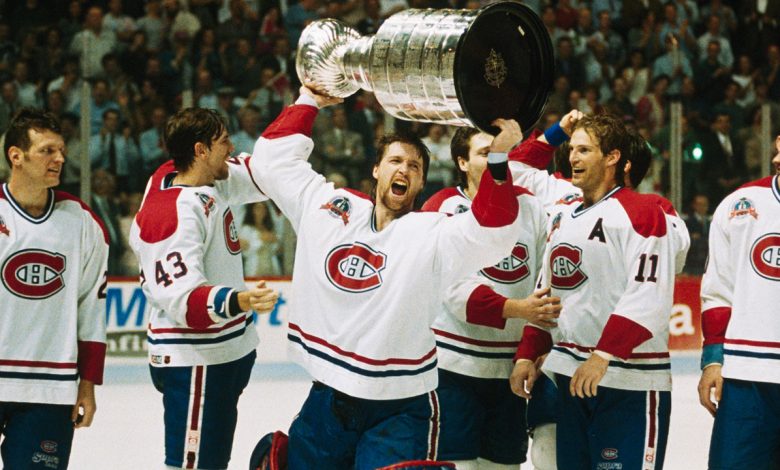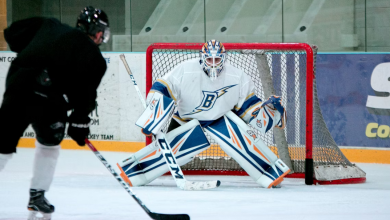Denis Savard speaks about Canada’s Stanley Cup drought since 1993

It’s crazy to think and believe but next season’s NHL playoffs will mark 30 years since a Canadian team has won the Stanley Cup.
The Edmonton Oilers were Canada’s last hope in 2022, but their sweep at the hands of the Colorado Avalanche in the Western Conference finals means the 1993 Montreal Canadiens remain the last team from north of the border to lift the iconic trophy.
Hall-of-Famer Denis Savard was part of that Montreal team that beat the Los Angeles Kings 5-1 in the 1993 Finals. Even now, nearly 30 years later, he remembers the winning moment and aftermath vividly.
“When I talk about it now, I still have goosebumps,” he told Betway Insider. “It’s an amazing feeling. Especially being a kid that grew up in Montreal.”
“Just to lift it – and it’s heavy, believe me. It’s the ultimate goal for any player to get to the final buzzer and to raise it up. It’s something that can never be taken away from you and something that as I watch the playoffs right now, it brings back a lot of great memories.
“That whole time, that whole summer was just incredible, just crazy. There were a lot of parties, I won’t lie to you, but rightly so. You can’t duplicate that, you can’t make that up.”
That was the only time Savard lifted the Stanley Cup during his illustrious 17-year, 1,196-game NHL career, but he might never have got there if not for a crucial moment in Game 2.
With the Kings 1-0 up in the series and closing in on a 2-1 victory to take a two-game lead back to LA, Canadiens head coach Jacques Demers called an illegal stick on defenseman Marty McSorley, who was given a two-minute minor.
Demers then pulled goaltender Patrick Roy to create a 6-on-4, and Eric Desjardins scored his second of the game to take it to overtime, before completing the hat-trick to win it.
“That was a big, big step for us to go on and win the Cup,” admits Savard. “We had our eyes on two guys, Marty McSorley being one, and Luc Robitaille being the other.
“Obviously, you want to win the right way,” he says. “It’s not that we didn’t win the right way, it was just a rule. In those days, that’s just the way it was.
“We knew that as players. We had teammates that played with illegal sticks, no question about it. So, it could have been us.
“I’ll be greedy, I’m glad we won either way. It is what it is, and it worked out good for us.”

Savard would never have predicted back that another Canadian team wouldn’t win a single Stanley Cup in the following 30 years, particularly considering Canada’s domination of the NHL from the mid-80s to early 90s.
There are multiple theories on the reasons behind the Stanley Cup drought in Canada, and Savard puts it down to two things.
Firstly, the sheer depth of talent in the modern NHL.
“It’s pretty incredible that it’s been so long,” he says. “That just tells you the depth of our league.
“You’ve got franchises now that came in a few years back and have made it to the Finals. It’s very tough to build a winner. It’s as simple as that.”
Secondly, Savard suggests that players are just not attracted by the prospect of playing in Canada at the moment, when compared to opportunities to go and play in the States.
“Players get a choice now,” he explains. “Being a free agent, they could go to Florida, play for the Panthers or for Tampa, you could go and play for Dallas.
“When Canadian teams get really close to getting there, and they need that free agent, in a lot of cases they don’t get them.
“They go with cities that are a little warmer for their families. Part of that has something to do with it, I think, free agent players choosing to go to other cities.”
Ultimately, though, players will head where they believe they have the best chance of winning, and Savard is confident that there are current teams in Canada that are attractive to free agents.
“I’ll give you an example, Toronto with [John] Tavares. He went and signed there thinking he could win a Cup,” he explains.
“With the Canadian teams, the closer they get to winning a Cup, free agents will go there. There is no question because the ultimate goal is to raise the Cup. It’s not a question of it just being Florida or Dallas.
“Toronto is not far off, they possibly could do it next year, or in the next two, three years. They have a great leader and a great player in Matthews, and a bunch of other stars.
“The best player in the world, Connor McDavid, is with the Edmonton Oilers and, sooner or later, if they surround him, they get him more help, there’s a chance that they could go on and win a few Cups in a row. That’s how good he is.”

Meanwhile others have pointed fingers at Gary Bettman, who has overseen the league’s southwards expansion into non-traditional hockey markets, is to blame for the scarcity of Stanley Cups in Canada in recent years.
Savard doesn’t agree.
“I like [expansion] personally,” he admits. “I think the league has done a great job, not just with that, but changing the rules over the years. The salary cap has really created parity in the league.
“Vegas was in the Finals a few years ago, that’s a new team in the league. It brought a lot of attention, a lot of people wanted to watch that.
“With how the playoffs are structured now, you had the Rangers against Pittsburgh in the first round, you had the Battle of Alberta in the second. How much better could it get?
“I think that all the changes they’ve made, they’ve made for the better. Our league is very healthy. Crowds come to the games, we have so many superstars. Right now, it’s very attractive.”
Savard is also positive about the future of hockey in Canada, despite the recent drought of playoff success north of the border.
“Canada’s the game. Hockey is our game,” he says. “I don’t think it’s ever going away. Ever. Sooner or later, it’s going to happen.
“You look at all the Canadian teams right now, Edmonton is close, Calgary’s close, Toronto is very, very capable of winning it in the next two or three years. I think they’ve learned a lot over the last two years. It’s a learning process.
“I don’t think [the drought] is going to hurt our game at all. As long as the teams stay competitive, which they will, we’re going to be fine.”


[…] Source link […]
[…] Source link […]